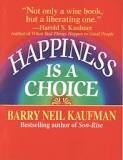I just finished reading Happiness Is a Choice by Barry Neil Kaufman. Kaufman’s perspective is that happiness is a choice and we can learn tools that will enable us to be happy. Many years ago he decided to make love and happiness a priority and it greatly enhanced his life as a result.
Kaufman is a therapist, author, speaker and the founder of Option Institute. His own life was profoundly changed when his third child was diagnosed as severely autistic. He and his wife turned to God to find understanding and inspiration on how to deal with this challenging condition. They decided to embrace their son’s uniqueness and worked with him every day for over three years. Eventually their son overcame his autism completely, which is nearly unheard of in the medical field.
Through his work at the Option Institute Kaufman discovered that people who are successful in finding happiness share certain character traits. In his book he goes over each of these traits and shows us how to use them to have a happier life.
The qualities Kaufman and his group found were: make happiness a priority, personal authenticity, let go of judgments, be present, be grateful and decide to be happy. Let’s look at them one at a time.
The first is to make happiness the priority and bring happiness and love center stage. In our society we make happiness dependent upon achieving our goals. If a child is asked what they want, they might say a bike; a teenager might say a driver’s license; and an adult might say a better job or relationship. It’s not until people are in their sixties that they begin to talk about health, peace, happiness and love.
When a person was asked why they wanted an event or item, they said it would make them happy. Kaufman challenges this idea and said, “Why not be happy now and then pursue whatever we want?” (p. 176). He goes on to say if we don’t tie our happiness to getting something, we are free to do anything we want. We don’t need love, recognition or praise to feel good.
Second is personal authenticity, which is the freedom to be yourself, rather than suppressing your thoughts. Kaufman let go of a ÷≥friendship where the other person wanted unhappiness and anger reinforced. Instead, he found new friendships based on acceptance, respect and love. He said, “We cherished each other as we were rather than as we wanted the other person to be” (p. 128).
The third trait is to let go of judgments and accept people and situations as they are. When we discard judgments, we can embrace people and situations more openly. “Judgments about people and possibilities limit our thinking and what we might try to accomplish” (p. 201).
Kaufman goes on to say that we can challenge and change the judgments we make. “The secret to happiness lies not in events, but in our responses to them” (p. 208). As an example of this Kaufman talks about a family whose child had cerebral palsy. The parents thought his condition was terrible. When they let go of that judgment, they were able to discover the beauty in their child and discovered God in the condition. If we embrace situations without judgment, we can find the elements in every event that serve and teach us.
The fourth characteristic is to be present by learning to discard regrets about the past and worries about the present. One woman discovered that only when she stayed present did she truly experience God. She released the pain of her past and chose happiness as a gift to give herself and her loved ones. “Our focused attention greatly enhances the power and pleasure of any event, as well as our ability to handle and draw lessons from it. When someone speaks, we can look at her directly and listen to her words. . . thus amplifying our appreciation and understanding of her commentary as well as honoring her attempt to communicate with us” (p. 237).
Next is being grateful by appreciating specific people and events, even during hard times. When people are happy, they have a sense of gratitude. Kaufman found that as he walked the path to being happier and more loving, he never ceased to be awed by the blessing of inner peace he’s found.
He’s also recognized inner guidance and a “user-friendly” universe that makes happiness possible. When we are grateful we enjoy and appreciate an experience and see the blessing and wonder of it.
Last is deciding to be happy. This encompassed all the other qualities, for if we prioritize happiness we will be authentic, present, grateful and nonjudgmental. Kaufman ends by saying we can chose to live in happiness and love and greet everyone around us with appreciation and delight.
For me the idea of choosing to be happy is an exciting one. I can make happiness a priority in my life. I can create my world and how I respond to it. I can be happy no matter what challenges I’m facing by not judging the situation as good or bad, and by being grateful for all of life’s gifts. This book can help anyone who wants to be happier and is ready to take the next step into a fuller, richer, happier life.
Here is a YouTube video with Barry Neil Kaufman on Happiness Is A Choice- No Matter What
share this:



Its such as you read my thoughts! You seem to comprehend a whole lot approximately this, as if you wrote the e
book within it or anything. I think that you simply can do
with some % to pressure the content house a lttle bit, but
instead of that, this can be magnificent blog. An incredible read.
I am going to definitely be back.
Pretty! This has been an extremely wonderful article. Many thanks for providing this info.